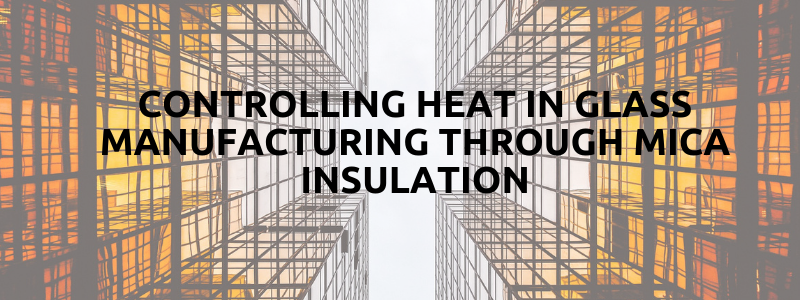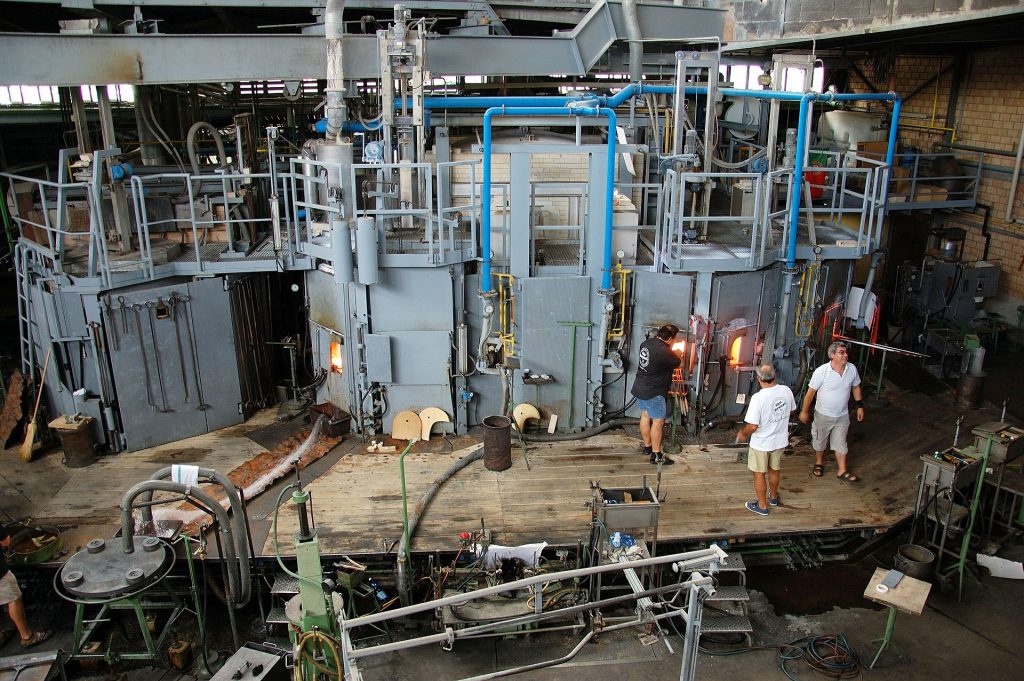
Mica insulation is an effective means of supporting glass manufacturing processes through the lining of glass furnaces.
Glass melting furnaces produce a wide range of glass, with hundreds of different varieties, especially of flat glass. The type of refractory used to melt glass will depend on several factors.
These include the corrosiveness of the glass being manufactured and its desired strength and resistance to temperature extremes. This also includes how often its basic makeup will require changing.
What glass furnaces have in common is a reliance on extreme temperatures, operating at around 1500°C. The evaluation of process hazard will largely determine the suitable refractory for each furnace.
This process hazard is inherent in glass manufacturing, because, with time, and under normal operating conditions, molten glass will erode the refractory of the furnace.
If it experiences sufficient wear, hot spots will then appear on the surface. These should be seen as a warning sign of likely further wear, which could break through the refractory and furnace wall.
Glass furnaces will usually run on a continual basis, therefore proactive maintenance and preventative measures are critical in glass manufacturing. Applying mica insulation is one of these measures.
Glass Properties and Uses
Glass is a material in regular use, which has an impact on people’s daily lives. It is chemically-resistant and transparent. These qualities have contributed to it still being a material of choice across a great many applications.
Because of this, choosing the right glass for a specific function or application is essential. As are the manufacturing processes for these different grades and types of glass.
Glass is familiar as tableware; as packaging in the form of bottles; in windscreens and in the construction of buildings, including houses and commercial structures. However, glass is also used in medical technology and radiation protection.
As a versatile material, glass continues to drive innovation.
Glass Manufacturing Processes
The manufacture of most types of glass involves processing raw materials, which are known as batch. Batch can include sand, limestone, soda ash, iron and carbon.
The critical aspect of glass manufacturing is using heat.
Batch is fed into a melter furnace, where the intense heat blends it together, transforming it into molten glass, ready for later shaping.
There are different ways of powering glass furnaces, including gas and oil, and the use of electricity a booster heat source to ensure furnaces reach and the required heat for melting glass.

Because of this continuous application of intense heat, furnaces for processing glass have limited lifespans, and they routinely consume a tremendous amount of energy.
Regulating Glass Manufacturing Temperatures
It is not enough simply to achieve these high temperatures. Glass manufacturing processes require good temperature regulation to condition the glass properly.
Furnaces will typically contain high temperature sensors to regulate the heat.
The key parameter in glass production is the viscosity, and this is directly related to the temperature of the glass. Monitoring glass temperatures accurately can improve cycle times and control the uniformity of finished glass products. Another essential aspect of controlling the heat in glass manufacturing is through effective, high temperature insulation.
Mica Insulation in Glass Manufacturing
The production of glass requires expert heat control, but good insulation also protects the critical assets central to glass manufacturing.
With continual use over time, the insulation that glass processing furnaces depend on can start to lose its essential properties through cracking. This damaged insulation will lead to heat loss, driving up energy costs. However, it can also have a direct impact on the quality of the finished glass.
When old insulation cracks, it more easily produces dust, which can then lead to quality issues in glass, such as white haze in tempered glass.
Mica is an ideal lining material for glass furnaces because it has superior slip plane characteristics, combined with exceptional thermal management and insulation properties.
Mica laminates come in a selection of grades, including glass mica.
Combining the natural mineral properties of mica with glass fibre reinforcement, these laminates are an extremely cost-effective solution for furnace linings.
There is a grade with a scrim glass reinforcing layer, which renders them tear-proof, even when applied to larger furnaces.
Other grades come with either single or double-sided glass fibre reinforcement.
Microporous Insulation for Glass Kilns
In addition to mica insulation, microporous technology provides insulation solutions in glass manufacturing. This innovative, high temperature insulation uses separation technology to create a porous material that reduces heat transfer significantly.
Elmelin’s Elmtherm range includes Elmtherm 1600. This is a composite which includes ceramics and is specially formulated to withstand temperatures of up to 1600°C, making it ideal for insulation in glass manufacturing, applied to kilns.
Supporting Continuous Processes through Insulation
We support the petrochemical, cement and glass manufacturing sectors, providing expert mica insulation and other thermal management solutions. For more information about how we can help your industry, please phone us now on +44 20 8520 2248, email sales@elmelin.com, or complete our online enquiry form. We will be in touch with you as soon as possible.
